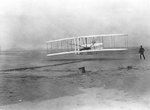Velius
Airman 1st Class
Hello all,
I've always wondered about this and I finally remembered to put this question on this site:
The Wright brothers were bicycle makers who designed and flew the first heavier than air aircraft (news flash huh? ). Anyway, why do you think they designed the flyer with skids instead of wheels?
). Anyway, why do you think they designed the flyer with skids instead of wheels?
Thanks 8)
I've always wondered about this and I finally remembered to put this question on this site:
The Wright brothers were bicycle makers who designed and flew the first heavier than air aircraft (news flash huh?
Thanks 8)



